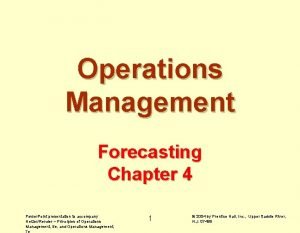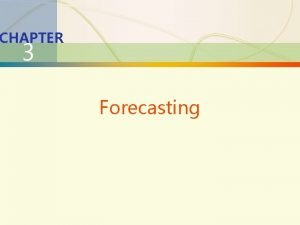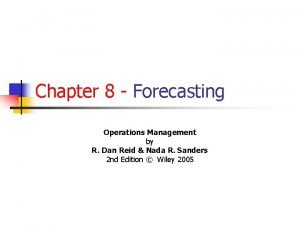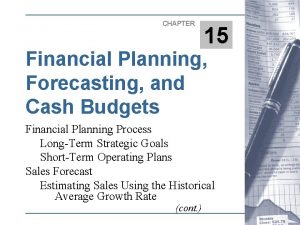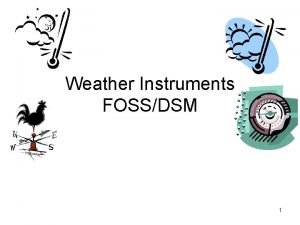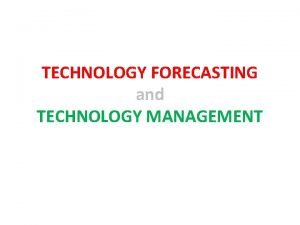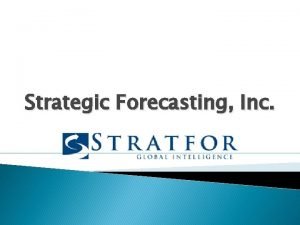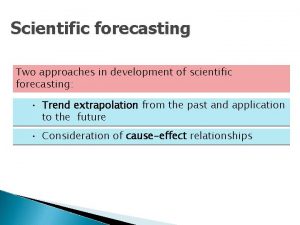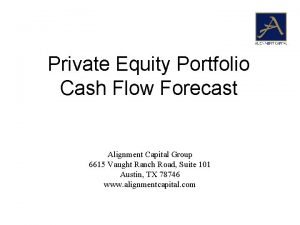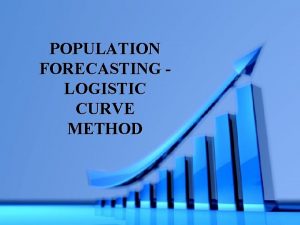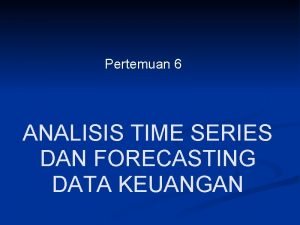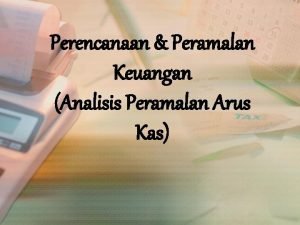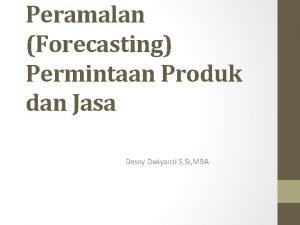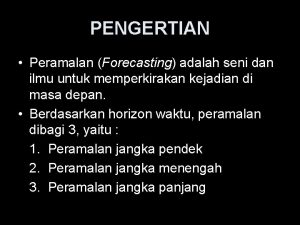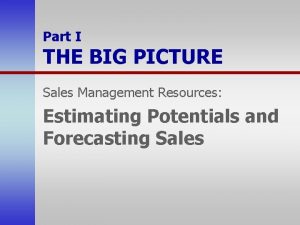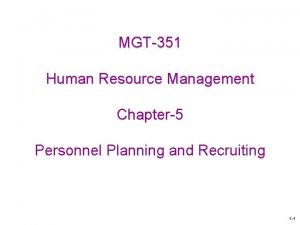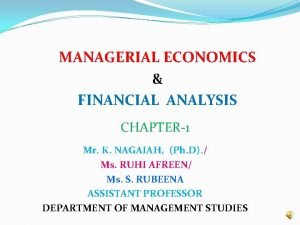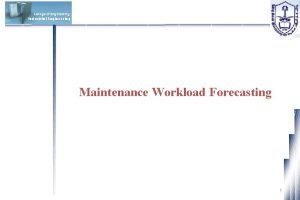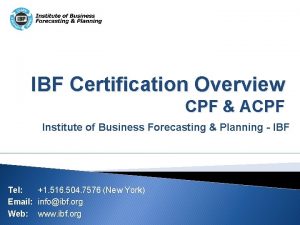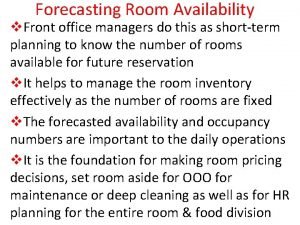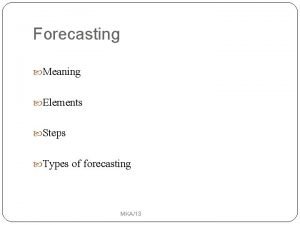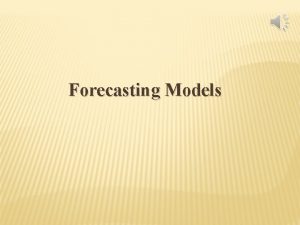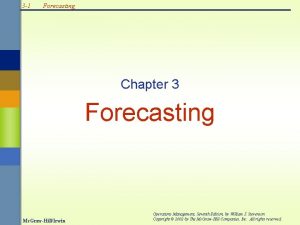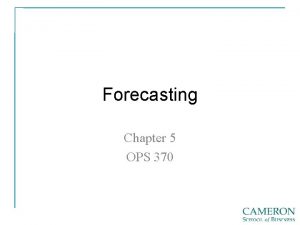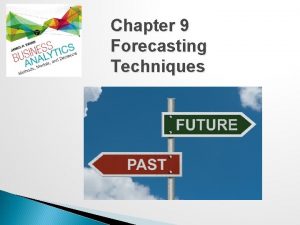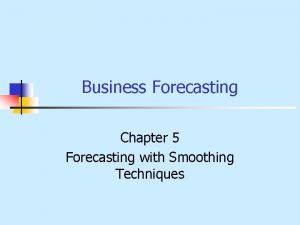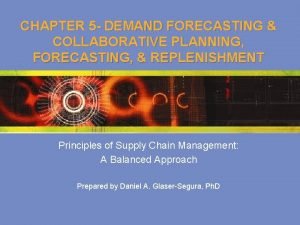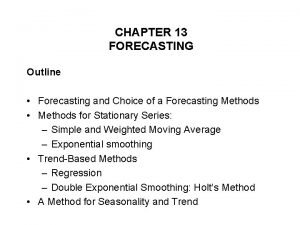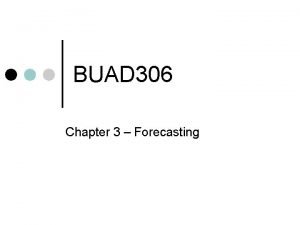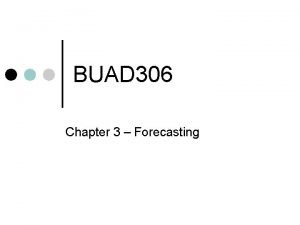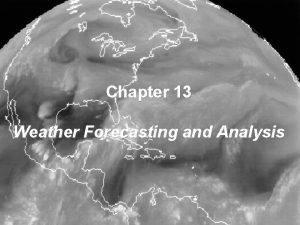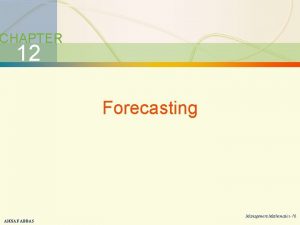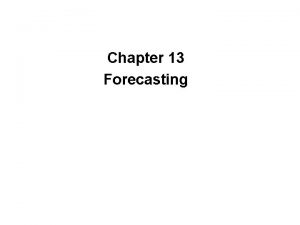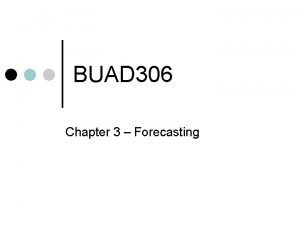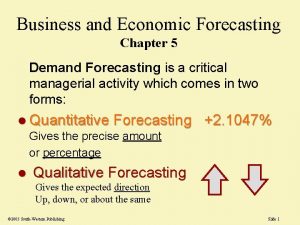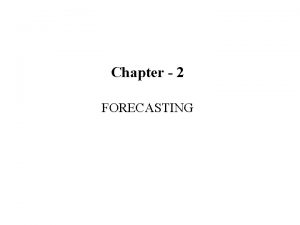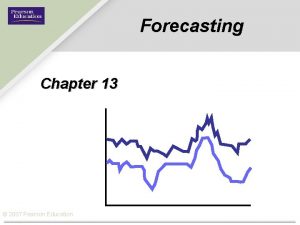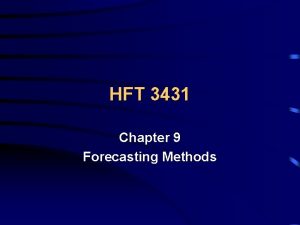3 1 Forecasting CHAPTER 3 Forecasting 3 2




























- Slides: 28

3 -1 Forecasting CHAPTER 3 Forecasting

3 -2 Forecasting FORECAST: · · A statement about the future value of a variable of interest such as demand. Forecasts affect decisions and activities throughout an organization · Accounting, finance · Human resources · Marketing · MIS · Operations · Product / service design

3 -3 Forecasting Uses of Forecasts Accounting Cost/profit estimates Finance Cash flow and funding Human Resources Hiring/recruiting/training Marketing Pricing, promotion, strategy MIS IT/IS systems, services Operations Schedules, MRP, workloads Product/service design New products and services

3 -4 Forecasting · Assumes causal system past ==> future · Forecasts rarely perfect because of randomness · Forecasts more accurate for groups vs. individuals · Forecast accuracy decreases as time horizon increases I see that you will get an A this semester.

3 -5 Forecasting Elements of a Good Forecast Timely Reliable ul M e f g n i an Accurate Written y s Ea to e s u

3 -6 Forecasting Steps in the Forecasting Process “The forecast” Step 6 Monitor the forecast Step 5 Prepare the forecast Step 4 Gather and analyze data Step 3 Select a forecasting technique Step 2 Establish a time horizon Step 1 Determine purpose of forecast

3 -7 Forecasting Types of Forecasts · Judgmental - uses subjective inputs · Time series - uses historical data assuming the future will be like the past · Associative models - uses explanatory variables to predict the future

3 -8 Forecasting Judgmental Forecasts · Executive opinions · Sales force opinions · Consumer surveys · Outside opinion · Delphi method · Opinions of managers and staff · Achieves a consensus forecast

3 -9 Forecasting Time Series Forecasts Trend - long-term movement in data · Seasonality - short-term regular variations in data · Cycle – wavelike variations of more than one year’s duration · Irregular variations - caused by unusual circumstances · Random variations - caused by chance ·

3 -10 Forecasting Forecast Variations Figure 3. 1 Irregular variation Trend Cycles 90 89 88 Seasonal variations

3 -11 Forecasting Naive Forecasts Uh, give me a minute. . We sold 250 wheels last week. . Now, next week we should sell. . The forecast for any period equals the previous period’s actual value.

3 -12 Forecasting Techniques for Averaging · Moving average · Weighted moving average · Exponential smoothing

3 -13 Forecasting · Moving Averages Moving average – A technique that averages a number of recent actual values, updated as new values become available. n MAn = · Ai i=1 n Weighted moving average – More recent values in a series are given more weight in computing the forecast.

3 -14 Forecasting Simple Moving Average Actual MA 5 MA 3 n MAn = Ai i=1 n

3 -15 Forecasting Exponential Smoothing Ft = Ft-1 + (At-1 - Ft-1) • Premise--The most recent observations might have the highest predictive value. · Therefore, we should give more weight to the more recent time periods when forecasting.

3 -16 Forecasting Exponential Smoothing Ft = Ft-1 + (At-1 - Ft-1) Weighted averaging method based on previous forecast plus a percentage of the forecast error · A-F is the error term, is the % feedback ·

3 -17 Forecasting Example 3 - Exponential Smoothing

3 -18 Forecasting Picking a Smoothing Constant Actual . 4 . 1

3 -19 Forecasting Associative Forecasting · Predictor variables - used to predict values of variable interest · Regression - technique for fitting a line to a set of points · Least squares line - minimizes sum of squared deviations around the line

3 -20 Forecasting Linear Model Seems Reasonable Computed relationship A straight line is fitted to a set of sample points.

3 -21 Forecasting Forecast Accuracy · Error - difference between actual value and predicted value · Mean Absolute Deviation (MAD) · · Mean Squared Error (MSE) · · Average absolute error Average of squared error Mean Absolute Percent Error (MAPE) · Average absolute percent error

3 -22 Forecasting MAD, MSE, and MAPE MAD = Actual forecast n MSE = ( Actual forecast) 2 n -1 MAPE = ( Actual forecast / Actual*100) n

3 -23 Forecasting Example 10

3 -24 Forecasting Choosing a Forecasting Technique No single technique works in every situation · Two most important factors · Cost · Accuracy · · Other factors include the availability of: Historical data · Computers · Time needed to gather and analyze the data · Forecast horizon ·

3 -25 Forecasting Exponential Smoothing

3 -26 Forecasting Linear Trend Equation

3 -27 Forecasting Simple Linear Regression

3 -28 Forecasting Workload/Scheduling SSU 9 United Airlines example
 Operations management chapter 4 forecasting solutions
Operations management chapter 4 forecasting solutions Chapter 3 forecasting
Chapter 3 forecasting Forecasting
Forecasting Chapter 15 financial forecasting for strategic growth
Chapter 15 financial forecasting for strategic growth Zero based forecasting in hrm
Zero based forecasting in hrm What does a wind vane measure
What does a wind vane measure What is color forecasting
What is color forecasting Hotel demand forecasting
Hotel demand forecasting Forecasting and management of technology
Forecasting and management of technology Strategic forecasting inc
Strategic forecasting inc Cash flow forecasting in software project management
Cash flow forecasting in software project management The two general approaches to forecasting are
The two general approaches to forecasting are Private equity cash flow forecasting
Private equity cash flow forecasting Logistic curve method formula
Logistic curve method formula Tiga pendekatan dalam analisis time series
Tiga pendekatan dalam analisis time series Perencanaan dan peramalan keuangan
Perencanaan dan peramalan keuangan Contoh peramalan permintaan produk
Contoh peramalan permintaan produk 7 langkah peramalan
7 langkah peramalan Naive method forecasting
Naive method forecasting Retail execution
Retail execution Forecasting the supply of inside candidates
Forecasting the supply of inside candidates Statistical methods of demand forecasting
Statistical methods of demand forecasting Demand forecasting and estimation
Demand forecasting and estimation Contoh soal metode rata rata bergerak
Contoh soal metode rata rata bergerak Technology forecasting
Technology forecasting Industrial engineering forecasting
Industrial engineering forecasting Ibf forecasting
Ibf forecasting Forecasting in front office
Forecasting in front office Forecast horizon
Forecast horizon
